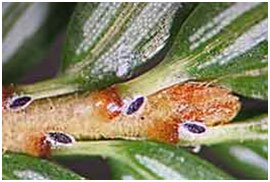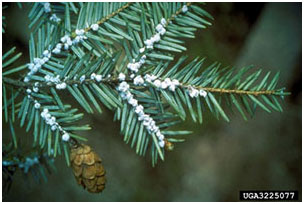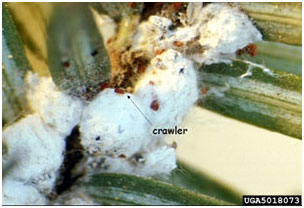Hemlock Woolly Adelgid
| What is the Hemlock Woolly Adelgid? | ||
 The hemlock woolly adelgid, or HWA, is an invasive, aphid-like insect that attacks North American hemlocks. HWA are very small (1.5 mm) and often hard to see, but they can be easily identified by the white woolly masses they form on the underside of branches at the base of the needles. These masses, or ovisacs, can contain up to 200 eggs and remain present throughout the year. The hemlock woolly adelgid, or HWA, is an invasive, aphid-like insect that attacks North American hemlocks. HWA are very small (1.5 mm) and often hard to see, but they can be easily identified by the white woolly masses they form on the underside of branches at the base of the needles. These masses, or ovisacs, can contain up to 200 eggs and remain present throughout the year. Where is HWA located? Native to Asia, HWA was introduced to the western United States in the 1920s. HWA was first discovered in New York State in 1985 in the lower Hudson Valley and on Long Island. Since the initial infestation, HWA has continued to spread north to the Capitol Region and west, through the Catskill Mountains and the Finger Lakes Region, into western NY. Most recently, HWA was found in the Adirondack Park.  White woolly egg masses. Photo: Connecticut White woolly egg masses. Photo: ConnecticutAgriculture Experiment Station, Bugwood.org Prospect Mountain Update In the summer of 2017, HWA was discovered in the Town of Lake George, the first known occurrence in the Adirondack Park. A press release of the incident can be found on DEC's website. After several weeks of detailed surveys within a 5-mile radius of the three infested trees, a treatment plan was developed in accordance with the State Environmental Quality Review Act, a summary of which was published in the ENB on 9/20/17. On October 16 and 17, Division of Lands & Forest staff, with assistance from the Adirondack Park Invasive Plant Program (APPIP), conducted the insecticide treatment of 218 trees within a 7-acre area surrounding the original infestation. The objective is to kill HWA on infested trees, protect uninfected trees, and halt the spread of HWA to new locations within the Adirondack Park. For more detailed information regarding insecticides, see sections below. What does HWA do to trees?  Photo: Pennsylvania Department of Conservation Photo: Pennsylvania Department of Conservationand Natural Resources - Forestry, Bugwood.org Once hatched, juvenile HWA, known as crawlers, search for suitable sites on the host tree, usually at the base of the needles. They insert their long mouthparts and begin feeding on the tree's stored starches. HWA remain in the same spot for the rest of their lives, continually feeding and developing into adults. Their feeding severely damages the canopy of the host tree by disrupting the flow of nutrients to its twigs and needles. Tree health declines, and mortality usually occurs within 4 to 10 years. What trees are affected? All species of hemlock are vulnerable to attack, but severe damage and death typically occurs in eastern (Tsuga canadensis) and Carolina (Tsuga caroliniana) hemlocks only. Eastern hemlock is the most common species of hemlock in New York State. What are the signs of an infestation?
What is the impact on NYS ecosystems? Hemlocks are ecologically important due to the unique environmental conditions they create under their dense canopies. These cooler, darker and sheltered environments are critical to the survival of a variety of species that rely on them for food, protection, and ideal growing conditions. Moose, black bears, salamanders, and migrating birds, as well as unique lichen and plant communities, are all closely associated with the hemlock ecosystem. Well suited for growing on steep slopes where not many other species can grow, hemlocks stabilize shallow soils and provide erosion control. In addition, they are often found along streams, where their shade helps moderate water temperatures, maintaining a suitable environment for cold-water species such as trout. Removal of hemlocks from NYS ecosystems can dramatically change ecosystem processes and may result in the loss of unique plants and wildlife. What is being done? Biological Control Several predators from Asia have been successfully introduced in HWA-infested areas. In addition, Laricobius nigrinus, a beetle native to the Pacific Northwest, has been released at various locations in the Finger Lakes region with promising results, though more controls are needed to stop HWA. Chemical Control Chemical insecticides can be used to treat an already infested tree or as a preventive measure in a high-risk infestation area. They are useful for treating individual, ornamental, or high-value trees, but are not practical or economical in a forest setting. Two insecticides that have shown promising results are Imidacloprid and Dinotefuran. Both must be applied by a licensed pesticide applicator, and either can kill HWA on its own. Applying both insecticides to an infested tree, however, combines the immediate effectiveness of the fast-acting Dinotefuran with the long-term protection of Imidacloprid, leaving the tree adelgid free for up to seven years. For more information about chemical control of HWA, please see NYSDEC's Frequently Asked Questions document (PDF, 640 KB). Integrated Pest Management The most effective management strategy for controlling HWA combines the short-term protection of insecticides with the long-term solution of biological control agents. As research continues the effectiveness of natural enemies to control HWA populations, chemical insecticides can keep trees alive and free of infestation until natural enemies take over. What can I do? If you believe you have found HWA...
More about Hemlock Woolly Adelgid:
|
||
 |
||
|
| What is the Hemlock Woolly Adelgid? | ||
 The hemlock woolly adelgid, or HWA, is an invasive, aphid-like insect that attacks North American hemlocks. HWA are very small (1.5 mm) and often hard to see, but they can be easily identified by the white woolly masses they form on the underside of branches at the base of the needles. These masses, or ovisacs, can contain up to 200 eggs and remain present throughout the year. The hemlock woolly adelgid, or HWA, is an invasive, aphid-like insect that attacks North American hemlocks. HWA are very small (1.5 mm) and often hard to see, but they can be easily identified by the white woolly masses they form on the underside of branches at the base of the needles. These masses, or ovisacs, can contain up to 200 eggs and remain present throughout the year. Where is HWA located? Native to Asia, HWA was introduced to the western United States in the 1920s. HWA was first discovered in New York State in 1985 in the lower Hudson Valley and on Long Island. Since the initial infestation, HWA has continued to spread north to the Capitol Region and west, through the Catskill Mountains and the Finger Lakes Region, into western NY. Most recently, HWA was found in the Adirondack Park.  White woolly egg masses. Photo: Connecticut White woolly egg masses. Photo: ConnecticutAgriculture Experiment Station, Bugwood.org Prospect Mountain Update In the summer of 2017, HWA was discovered in the Town of Lake George, the first known occurrence in the Adirondack Park. A press release of the incident can be found on DEC's website. After several weeks of detailed surveys within a 5-mile radius of the three infested trees, a treatment plan was developed in accordance with the State Environmental Quality Review Act, a summary of which was published in the ENB on 9/20/17. On October 16 and 17, Division of Lands & Forest staff, with assistance from the Adirondack Park Invasive Plant Program (APPIP), conducted the insecticide treatment of 218 trees within a 7-acre area surrounding the original infestation. The objective is to kill HWA on infested trees, protect uninfected trees, and halt the spread of HWA to new locations within the Adirondack Park. For more detailed information regarding insecticides, see sections below. What does HWA do to trees?  Photo: Pennsylvania Department of Conservation Photo: Pennsylvania Department of Conservationand Natural Resources - Forestry, Bugwood.org Once hatched, juvenile HWA, known as crawlers, search for suitable sites on the host tree, usually at the base of the needles. They insert their long mouthparts and begin feeding on the tree's stored starches. HWA remain in the same spot for the rest of their lives, continually feeding and developing into adults. Their feeding severely damages the canopy of the host tree by disrupting the flow of nutrients to its twigs and needles. Tree health declines, and mortality usually occurs within 4 to 10 years. What trees are affected? All species of hemlock are vulnerable to attack, but severe damage and death typically occurs in eastern (Tsuga canadensis) and Carolina (Tsuga caroliniana) hemlocks only. Eastern hemlock is the most common species of hemlock in New York State. What are the signs of an infestation?
What is the impact on NYS ecosystems? Hemlocks are ecologically important due to the unique environmental conditions they create under their dense canopies. These cooler, darker and sheltered environments are critical to the survival of a variety of species that rely on them for food, protection, and ideal growing conditions. Moose, black bears, salamanders, and migrating birds, as well as unique lichen and plant communities, are all closely associated with the hemlock ecosystem. Well suited for growing on steep slopes where not many other species can grow, hemlocks stabilize shallow soils and provide erosion control. In addition, they are often found along streams, where their shade helps moderate water temperatures, maintaining a suitable environment for cold-water species such as trout. Removal of hemlocks from NYS ecosystems can dramatically change ecosystem processes and may result in the loss of unique plants and wildlife. What is being done? Biological Control Several predators from Asia have been successfully introduced in HWA-infested areas. In addition, Laricobius nigrinus, a beetle native to the Pacific Northwest, has been released at various locations in the Finger Lakes region with promising results, though more controls are needed to stop HWA. Chemical Control Chemical insecticides can be used to treat an already infested tree or as a preventive measure in a high-risk infestation area. They are useful for treating individual, ornamental, or high-value trees, but are not practical or economical in a forest setting. Two insecticides that have shown promising results are Imidacloprid and Dinotefuran. Both must be applied by a licensed pesticide applicator, and either can kill HWA on its own. Applying both insecticides to an infested tree, however, combines the immediate effectiveness of the fast-acting Dinotefuran with the long-term protection of Imidacloprid, leaving the tree adelgid free for up to seven years. For more information about chemical control of HWA, please see NYSDEC's Frequently Asked Questions document (PDF, 640 KB). Integrated Pest Management The most effective management strategy for controlling HWA combines the short-term protection of insecticides with the long-term solution of biological control agents. As research continues the effectiveness of natural enemies to control HWA populations, chemical insecticides can keep trees alive and free of infestation until natural enemies take over. What can I do? If you believe you have found HWA...
More about Hemlock Woolly Adelgid:
|
||
 |
||
|




